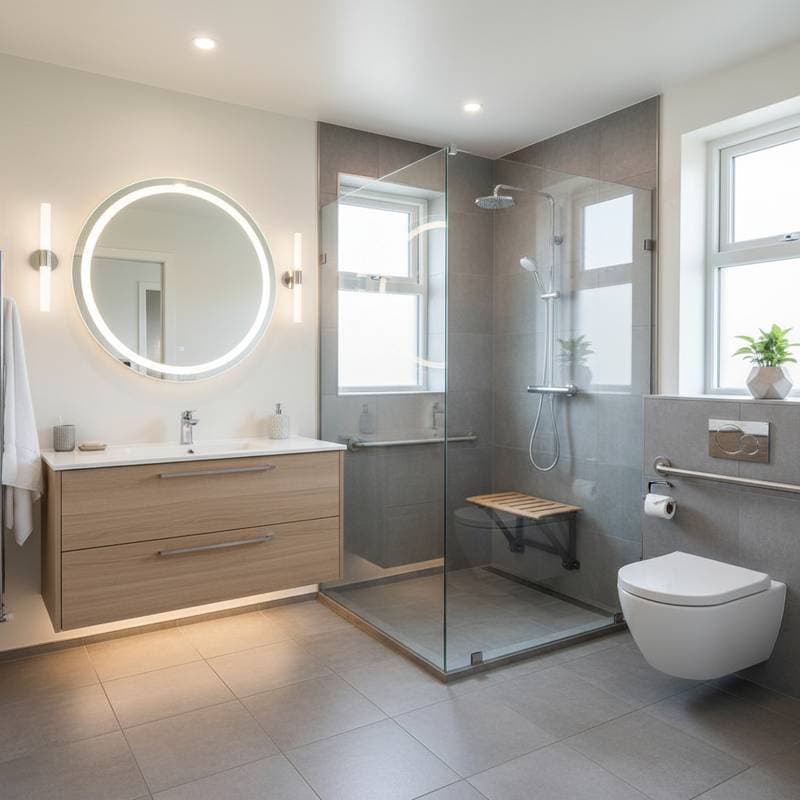2025 Safety Trends for Aging-in-Place Bathrooms
Contemporary bathroom design emphasizes independence through a balance of innovation, comfort, and aesthetics. These trends facilitate daily activities for individuals of all ages and abilities, whether in a family residence, a lifelong home, or a client project. Safety enhancements integrate harmoniously with elegant features to support graceful aging.
Universal Design with Personalized Elements
Universal design principles create environments suitable for diverse needs. Current developments focus on customization, allowing safety elements to appear bespoke rather than institutional. Examples include grab bars that function as towel holders, shower seats in warm wood tones, and slip-resistant floors resembling natural stone.
Manufacturers provide fixtures in varied finishes, forms, and textures to meet these preferences. Traditional chrome and stainless steel yield to options like matte black, champagne bronze, and brushed nickel. This approach results in bathrooms that convey modernity without a clinical feel.
Budget Consideration: A standard brushed nickel grab bar costs approximately 30 dollars. For added elegance, a designer version that serves as a shelf or towel rack ranges from 75 to 200 dollars. Both deliver essential safety, with selection based on aesthetic and financial priorities.
Smart Technology for Enhanced Safety
Advanced technology simplifies routines and reduces risks. Smart faucets, temperature sensors, and voice-activated lights streamline tasks. For instance, a voice command can initiate shower water at a preset temperature, eliminating the need to manipulate controls manually.
Smart mirrors track humidity and illumination levels, while motion-activated nightlights illuminate paths during nighttime use. These elements mitigate common hazards such as slips and scalding injuries.
Affordable Entry Points: Motion-sensor plug-in nightlights cost about 10 dollars, and smart light switches around 40 dollars. Integrated voice-controlled systems for lighting and water control range from 300 to 700 dollars, offering scalability for different budgets.
Low-Threshold and Zero-Entry Showers
High bathtub thresholds pose challenges for those with mobility limitations. Zero-entry showers address this by providing a flush transition from the bathroom floor to the shower area, enhancing both safety and visual continuity.
These designs often incorporate linear drains for a streamlined appearance and efficiency. Designers delineate the shower zone with subtle tile variations or mosaic accents, evoking a spa atmosphere while adhering to accessibility standards.
Professional Advice: Converting a tub to a low-threshold entry typically costs 1,000 to 2,000 dollars, influenced by labor and materials. A complete zero-entry tiled shower begins at around 4,000 dollars, justifying the investment through improved safety and property value.
Slip-Resistant Flooring with Luxurious Textures
Modern flooring prioritizes traction alongside elegance. Porcelain and vinyl materials replicate the look of marble, slate, or wood, maintaining grip even when wet.
Cushioned vinyl introduces subtle padding for comfort and impact absorption in case of falls. This blend of functionality and sophistication suits various design preferences.
Cost Overview:
- Slip-resistant vinyl tiles: 2 to 4 dollars per square foot
- Textured porcelain tiles: 5 to 10 dollars per square foot
- Cushioned luxury vinyl: 4 to 7 dollars per square foot
Options accommodate constrained or expansive budgets while ensuring durable, attractive surfaces.
Adaptive Lighting for Safety and Comfort
Effective lighting influences visibility and well-being. Adaptive systems automatically modify intensity and tone from soft morning diffusion to task-oriented brightness, then evening warmth, minimizing shadows and glare that lead to accidents.
Layered approaches combine ceiling fixtures, under-cabinet illumination, mirror-integrated lights, and low-level LED strips near key areas. This setup fosters security and ease of navigation.
Accessible Upgrades: Swap bulbs for daylight-balanced LEDs under 20 dollars. Install a motion-sensor vanity strip for an additional 15 dollars. Programmable adaptive systems cost 200 to 500 dollars, providing tailored control.
Comfort-Height Fixtures and Ergonomic Hardware
Minor modifications yield significant usability gains. Comfort-height toilets, elevated vanities, and lever handles accommodate varied physical capabilities. Lever designs assist those with arthritis or reduced dexterity, while presenting a contemporary profile.
Comfort-height toilets rise about two inches above standard models, easing transitions. Wall-mounted vanities allow height adjustments, promoting openness and accessibility.
Pricing Guidance: Basic comfort-height toilets start at 150 dollars, with premium models up to 600 dollars. Lever faucets begin at 40 dollars and support straightforward installation.
Integrated Grab Bars for Discreet Support
Innovative grab bars integrate into decor as towel rails, shelves, or corner ledges. This evolution of universal design maintains aesthetics without compromising stability.
For temporary needs, tension or suction models offer non-invasive support; verify weight capacities and optimal positioning.
Installation Recommendation: Reinforce walls during renovations to facilitate future grab bar additions, ensuring preparedness without immediate commitment.
Temperature Controls and Touchless Features
Precise temperature management prevents burns. Anti-scald valves and thermostatic mixers regulate water flow, benefiting users with diminished reflexes or sensitivity.
Touchless faucets and dispensers minimize contact, curbing germ transmission and simplifying hygiene. Battery- or plug-powered units enhance convenience with a modern aesthetic suitable for diverse styles.
Investment Examples:
- Anti-scald valve: 75 dollars
- Touchless faucet: 100 to 250 dollars
- Touchless soap dispenser: 25 dollars
These additions deliver substantial safety benefits alongside practical enhancements.
Accessible Storage Configurations
Effective storage streamlines access to essentials, reducing strain. Pull-out drawers, adjustable shelves, and open units position items at convenient heights. Organizers like lazy Susans and dividers maintain order and visibility.
In multi-user spaces, tiered zones ensure equitable reach. Such arrangements exemplify considerate, inclusive planning.
Simple Enhancements: A pull-out sink basket costs under 30 dollars. Soft-close drawer installations begin at 200 dollars per vanity for comprehensive updates.
Implementing Adaptable Bathroom Upgrades
These trends offer flexibility for incremental or comprehensive changes. Prioritize features aligned with immediate needs, such as enhanced flooring, a handheld shower, or optimized lighting.
Each improvement contributes to sustained usability and reassurance. Focus on designs that prioritize well-being over chronological age, creating enduring, supportive environments.










